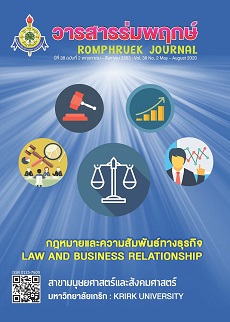การจัดการเรียนรู้แบบเพื่อนช่วยเพื่อนของผู้เรียนที่มีความบกพร่องทางการได้ยิน และผู้เรียนปกติ
Main Article Content
บทคัดย่อ
การเรียนรู้แบบเพื่อนช่วยเพื่อน (Peer-Assisted Learning : PAL) เป็นหนึ่งในกลยุทธ์ทางการศึกษาที่สามารถช่วยเหลือการเรียนรู้ของผู้เรียนและการพัฒนาวิชาชีพ เมื่อรวมกับกลยุทธ์การเรียนรู้ที่เน้นผู้เรียนเป็นศูนย์กลาง เช่น การเรียนรู้แบบทีม จุดประสงค์ของการศึกษาครั้งนี้ คือ การวิเคราะห์แนวคิดของการเรียนรู้แบบเพื่อนช่วยเพื่อนที่เกี่ยวข้องกับการเรียนรู้แบบทีมที่มีต่อประสบการณ์การเรียนรู้ของผู้เรียนที่มีความบกพร่องทางการได้ยินและผู้เรียนปกติ ผ่านการฝึกจับคู่ที่ผู้เรียนแบ่งปันความรู้ ตรวจสอบและให้คำแนะนำเพื่อน ผลการศึกษา พบว่า วิธีการเรียนแบบเพื่อนช่วยเพื่อนจะประสบผลสําเร็จเมื่อผู้สอนและผู้เรียนมีความรู้ความเข้าใจในเรื่องวิธีเรียนแบบเพื่อนช่วยเพื่อนเป็นอย่างดี ซึ่งช่วยให้ผู้สอนจัดกลุ่มการสื่อสารให้ผู้เรียนทราบถึงความสําคัญประโยชน์และวิธีการเรียนแบบเพื่อนช่วยเพื่อน
Article Details
ทุกบทความที่ตีพิมพ์ในวารสารมนุษยศาสตร์และสังคมศาสตร์ร่มพฤกษ์เป็นทัศนะและข้อคิดเห็นของผู้เขียนมิใช่ทัศนะของมหาวิทยาลัยเกริกหรือกองบรรณาธิการ การนำบทความส่วนใดส่วนหนึ่งหรือทั้งหมดไปพิมพ์เผยแพร่ต้องอ้างอิงที่มาให้ชัดเจน
เอกสารอ้างอิง
กระทรวงพัฒนาสังคมและความมั่นคงของมนุษย์. (2563). รายงานข้อมูลสถานการณ์ด้านคนพิการ
ในประเทศไทย ปี2563 กรมส่งเสริมและพัฒนาคุณภาพชีวิตคนพิการ. (10 มกราคม 2563)
สืบค้นจาก http://dep.go.th/Content/View/6113/1.
กาญจนา เดชภิญญา และ วีณัฐ สกุลหอม. (2562). การจัดระเบียบโลกใหม่ (New World Order)
กับการปรับตัวทางการศึกษาของประเทศไทย. วารสารร่มพฤกษ์, 37(2), 57-66.
จุไรรัตน์ สุดรุ่ง. (2559). การนิเทศภายในโรงเรียน. กรุงเทพฯ : แดเน็กซ์อินเตอร์คอร์ปอเรชั่น.
นันทวัน วัฒนมงคลสุข, วรพงษ์ คุณเดชอมร และ ศิรินาถ บูรณพงษ์. (2560). เทคนิคการสอนไวยากรณ์
ภาษาอังกฤษแบบ “เพื่อนช่วยเพื่อน”. JOURNAL OF AKHONRATCHASIMA COLLEGE,
(3), 277-287.
ธนาชัย สุนทรอนันตชัย. (2553). สิทธิ เสรีภาพ และความเสมอภาคทางด้านการศึกษาของคนพิการใน
ระดับอุดมศึกษา : ศึกษากรณีผู้ที่มีความบกพร่องทางการได้ยิน. นิติศาสตรมหาบัณฑิต
จุฬาลงกรณ์มหาวิทยาลัย, กรุงเทพฯ.
ทิศนา แขมมณี. (2556). ศาสตร์การสอนองค์ความรู้เพื่อการจัดกระบวนการเรียนรู้ที่มีประสิทธิภาพ.
กรุงเทพฯ : จุฬาลงกรณ์มหาวิทยาลัย.
วิจารณ์ พานิช. (2557). ผู้สอนเพื่อศิษย์สร้างห้องเรียนกลับทาง. กรุงเทพฯ : มูลนิธิสยามกัมมาจล.
ศรียา นิยมธรรม. (2544). ความบกพร่องทางการได้ยิน : ผลกระทบทางจิตวิทยา การศึกษา
และสังคม. กรุงเทพฯ : มหาวิทยาลัยศรีนครินทรวิโรฒ.
สุณีย์รัตน์ เนียรเจริญสุข. (2553). การเรียนรู้แบบเพื่อนช่วยเพื่อนกับการเรียนการสอนภาษาญี่ปุ่น.
วารสารญี่ปุ่นศึกษา. 27(1), 81-96.
สุพิน นาวง. (2553). การพัฒนารูปแบบการเรียนการสอนสำหรับนักศึกษาปริญญาบัณฑิตที่มี
ความพิการทางการได้ยินในสถาบันอุดมศึกษา. ครุศาสตรดุษฎีนิพนธ์ สาขาวิชาอุดมศึกษา
จุฬาลงกรณ์มหาวิทยาลัย, กรุงเทพฯ.
อนุชา ภูมิสิทธิพร. (2550). การศึกษาปัญหาและความต้องการของนักศึกษาที่มีความบกพร่อง
ทางการได้ยินที่ศึกษาในมหาวิทยาลัยราชภัฏ. การศึกษามหาบัณฑิต สาขาการศึกษาพิเศษ
มหาวิทยาลัยศรีนครินทรวิโรฒ, กรุงเทพฯ.
อารีลักษณ์ คีมทอง. (2544). กรณีศึกษาเกี่ยวกับการเลี้ยงดูบุตรของครอบครัวที่มีลูกหูหนวก.
ปริญญานิพนธ์มหาบัณฑิต สาขาวิชางานบริการฟื้นฟูสมรรถภาพคนพิการ วิทยาลัย
ราชสุดา มหาวิทยาลัยมหิดล, กรุงเทพฯ.
Aitao, L. (2015). Perceived physical appearance and life satisfaction : A moderated
Mediation model of self-esteem and life experience of deaf and hearing
Adolescents. Journal of adolescence, 39, 1-9.
Bournemouth University. (2002). Peer assisted learning. (January 10, 2020) Retrieved from
https://www.Bournemouth. ac.uk/students/library/guests-visitor-information/peer- assisted-learning-pal.
Giordana, S. & Wedin, B. (2010). Peer mentoring for multiple levels of nursing students.
Nurs Edu Perspect, 31(6), 394-396.
Lockspeiser, T.M., O'Sullivan, P., Teherani, A, & Muler, J. (2008). Understanding the
experience of being taught by peers : the value of social and cognitive
congruence. Adv Health Sci Educ Theory Pract, 13(3), 361-372.
Meertens, R. (2016). Utilisation of a peer assisted learning scheme in an undergraduate
diagnostic radiography module. Radiography, 22(1), 69-74.
Sri-on, J. (2006). Higher Education for Persons with Disabilities in Thailand. NTUT
Education Of Disabilities, 5, 37-39.
Theunissen, S. C., Rieffe, C., Netten, A. P., Briaire, J. J., Soede, W. & Kouwenberg, M.
(2014). Self-esteem in hearing-impaired children : the influence of communication
education, and audiological characteristics. PloS One, 9(4), 494-521.
Williams, B. & Reddy, P. (2016). Does peer-assisted learning improve academic
performance?. A scoping review, 42, 23-29.


